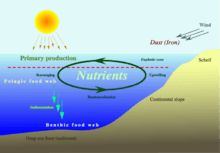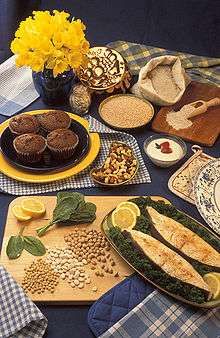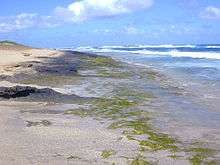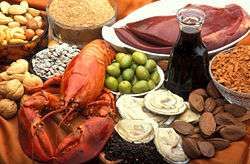营养素的解释和发音 「欧路词典」英汉
yíng yǎng sù
nutriment, nutrimental
翻译分析加载中...
提示:以上内容由AI生成,可能存在错误。反馈错误
1.Nutrients are absorbed into the bloodstream.
1.营养素被吸收进血液。
2.They a ist in tra mitting me ages, maintaining cardiac stability, and regulating metabolism and a orption of other nutrients.
2.它协助信息传递、维持心脏稳定、调节其他营养素的代谢和吸收。
声明:以上例句、词性分类均由互联网资源自动生成,部分未经过人工审核,其表达内容亦不代表本软件的观点;若发现问题,欢迎向我们指正。
Kurzgesagt 科普动画(双语精选)
1.It contains all necessary macronutrients and many micronutrients.
它包含所有必要的大量营养素和许多微量营养素。
WIL生活启示录
2.Protein is obviously a very vital nutrient.
蛋白质显然是一种非常重要的营养素。
《卫报》(文章版)
3.They can be deficient in crucial nutrients such as vitamin B-12.
纯素饮食可能缺乏维生素 B12 等关键营养素。
精选英语短文
4.The quantitative indicators of pig milk nutrients are currently being tested.
目前该团队正在测试猪奶营养素的定量指标。
WIL生活启示录
5.Protein is actually the most expensive macronutrient.
蛋白质实际上是最昂贵的常量营养素。
科学60秒-科学美国人 2024年3月合集
6.Malnutrition is not getting an adequate amount of specific nutrients.
营养不良是指没有获得足够数量的特定营养素。
WIL生活启示录
7.In this framework, you can think about macronutrients like this.
你可以在这个框架下考虑宏量营养素。
连线杂志
8.So there are three macronutrients that make up the bulk of food.
有三种常量营养素构成了食物的主体。
TED演讲(视频版)双语精选
9.These living muscles efficiently convert chemical energy that comes from nutrients into muscle contractions.
这些活肌把来自营养素的化学能量高效地转化为肌肉收缩。
健身知识科普
10.In summary, macros are the foundation of fitness nutrition and accounting for them can provide more effective diet strategies.
综上所述,巨量营养素是健身营养的基础,对营养素进行计算可以提供更有效的饮食策略。
Nutrient
营养素(英语:Nutrient,又称为养分)是人体所需的一些物质。主要分为人体需求量较大的宏量营养素和需求量较小的微量营养素。其中宏量营养素包括碳水化合物、脂肪、纤维素、蛋白质以及水。微量营养素包括矿物质和维生素。其中维生素又可细分为脂溶性维生素与水溶性维生素两大类。脂溶性维生素包括有:维生素A、D、E、K;水溶性维生素则包括有维生素B1、B2、B6、B12以及烟碱酸、叶酸、维生素C。
宏量营养素,除纤维素和水之外,主要为人体提供能量,以焦耳(jouls)或者卡路里(calories)来衡量。每克碳水化合物或蛋白质提供4千卡能量,每克脂肪提供9千卡能量。其他营养素,包括纤维素、水、矿物质和维生素,不提供能量,但在机体的生理活动中具有重要的作用。
脚注
↑ Berg J, Tymoczko JL, Stryer L. Biochemistry 5th. San Francisco: W.H. Freeman. 2002: 603. ISBN 0716746840.声明:以上百科文字由Wikimedia Foundation基于Creative Commons协议之条款提供。相关文字仅供参考,其表述的内容不代表本站观点。
如果您发现有不合适的内容,请向我们举报
Nutrient

Nutrient cycle in the oceans
Nutrients are components in foods that an organism uses to survive and grow. Macronutrients provide the bulk energy an organism's metabolic system needs to function while micronutrients provide the necessary cofactors for metabolism to be carried out. Both types of nutrients can be acquired from the environment. Micronutrients are used to build and repair tissues and to regulate body processes while macronutrients are converted to, and used for, energy. Methods of nutrient intake are different for plants and animals. Plants take in nutrients directly from the soil through their roots and from the atmosphere through their leaves. Animals and protists have specialized digestive systems that work to break down macronutrients for energy and utilize micronutrients for both metabolism and anabolism (constructive synthesis) in the body.
Organic nutrients consist of carbohydrates, fats, proteins (or their building blocks, amino acids), and vitamins. Organic chemical compounds such as dietary minerals, water (H2O), and oxygen may also be considered nutrients. A nutrient is considered essential if it must be obtained from an external source either because the organism cannot synthesize it or because insufficient quantities are produced. Nutrients needed in very small amounts are called micronutrients while those needed in large quantities are called macronutrients. The effects of nutrients are dose-dependent; shortages are called deficiencies.
Types of nutrient

Good sources of magnesium: bran muffins, pumpkin seeds, barley, buckwheat flour, low-fat vanilla yogurt, trail mix, halibut steaks, garbanzo beans, lima beans, soybeans, and spinach
Macronutrients are defined in several different ways.
The chemical elements humans consume in the largest quantities are carbon, hydrogen, nitrogen, oxygen, phosphorus, and sulphur, or CHNOPS. The classes of chemical compounds humans consume in the largest quantities and which provide bulk energy are carbohydrates, proteins, and fats. Water and atmospheric oxygen also must be consumed in large quantities, but are not always considered "food" or "nutrients". Calcium, salt (sodium and chloride), magnesium, and potassium (along with phosphorus and sulfur) are sometimes added to the list of macronutrients because they are required in large quantities compared to other vitamins and minerals. They are sometimes referred to as the macrominerals.Substances that provide energy
Carbohydrates are compounds made up of types of sugars. Carbohydrates are classified by their number of sugar units: monosaccharides (such as glucose and fructose), disaccharides (such as sucrose and lactose), oligosaccharides, and polysaccharides (such as starch, glycogen, and cellulose). Proteins are organic compounds that consist of amino acids joined by peptide bonds. The body cannot manufacture some of the amino acids (termed essential amino acids); the diet must supply them. Proteins, in nutrition, are broken down through digestion by proteases back into free amino acids. Fats consist of a glycerin molecule with three fatty acids attached. Fatty acids are unbranched hydrocarbon chains,1 connected by single bonds alone (saturated fatty acids) or by both double and single bonds (unsaturated fatty acids). Fats are needed to keep cell membranes functioning properly, to insulate body organs against shock, to keep body temperature stable, and to maintain healthy skin and hair. The body does not manufacture certain fatty acids (termed essential fatty acids) and the diet must supply them.Although alcohol provides energy, and can thus be compared to macronutrients, it is not a substance that is essential for normal function. The acetic acid in vinegar also provides a similar amount of energy per gram, but again, it is not a nutrient because it is not essential for normal function.
Fat has an energy content of 9 kcal/g (~37.7 kJ/g); proteins and carbohydrates 4 kcal/g (~16.7 kJ/g). Ethanol (grain alcohol) has an energy content of 7 kcal/g (~29.3 kJ/g).
Substances that support metabolism
Dietary minerals are generally trace elements, salts, or ions such as copper and iron. Some of these minerals are essential to human metabolism. Vitamins are organic compounds essential to the body. They usually act as coenzymes or cofactors for various proteins in the body. Water is an essential nutrient and is the solvent in which all the chemical reactions of life take place.
The strip of a green alga (Enteromorpha) along this shore indicates that there is a nearby source of nutrients (probably nitrates or ammonia from a small estuary).
Plants absorb nutrients from the soil or the atmosphere, or from water (mainly aquatic plants). An exception are the carnivorous plants, which externally digest nutrients from animals before ingesting them.
The chemical elements consumed in the greatest quantities by plants are carbon, hydrogen, and oxygen. These are present in the environment in the form of water and carbon dioxide; energy is provided by sunlight. Nitrogen, phosphorus, and sulfur are also needed in relatively large quantities. Together, the "Big Six" are the elemental macronutrients for all organisms, often represented by the acronym CHNOPS. Usually they are sourced from inorganic (e.g. carbon dioxide, water, nitrate, phosphate, sulfate) or organic (e.g. carbohydrates, lipids, proteins) compounds, although elemental diatomic molecules of nitrogen and (especially) oxygen are often used.
Other chemical elements are also necessary to carry out various life processes and build structures; see fertilizer and micronutrient for more information.

Rich sources of copper: oysters, beef or lamb liver, Brazil nuts, blackstrap molasses, cocoa, and black pepper. Good sources: lobster, nuts and sunflower seeds, green olives, and wheat bran.
Some of these are considered micronutrients in certain organisms. The mnemonic C. HOPKN'S CaFe Mg (to be used as C. Hopkins coffee mug) is used by some students to remember the list as: carbon, hydrogen, oxygen, phosphorus, potassium, nitrogen, sulfur, calcium, iron, and magnesium. Silicon, chloride, sodium, copper, zinc, and molybdenum are sometimes also included, but are in other cases considered micronutrients.
Essential and non-essential nutrients
Nutrients are frequently categorized as essential and nonessential.
Essential nutrients
Essential nutrients are unable to be synthesized internally (either at all, or in sufficient quantities), and so must be consumed by an organism from its environment. Nonessential nutrients are those nutrients that can be made by the body; they may often also be absorbed from consumed food. The majority of animals ultimately derive their essential nutrients from plants, though some animals may consume mineral-based soils to supplement their diet.
For humans, these include essential fatty acids, essential amino acids, vitamins, and certain dietary minerals. Oxygen and water are also essential for human survival, but are generally not considered "food" when consumed in isolation. There are no "essential carbohydrates", animals can synthesize all the types of carbohydrates needed for growth.
Humans can derive energy from a wide variety of fats, carbohydrates, proteins, and simple chemicals such as ethanol and acetic acid.
Non-essential nutrients
Non-essential nutrients are substances within foods can still have a significant impact on health, whether beneficial or toxic. For example, most dietary fiber is not absorbed by the human digestive tract, but is important in maintaining the bulk of a bowel movement to avoid constipation.
Interest has recently increased in phytochemicals, which include many non-essential substances which may or may not have health benefits.
Deficiencies and toxicity
An inadequate amount of a nutrient is a deficiency. Deficiencies can be due to a number of causes including inadequacy in nutrient intake called dietary deficiency, or conditions that interfere with the utilization of a nutrient within an organism. Some of the conditions that can interfere with nutrient utilization include problems with nutrient absorption, substances that cause a greater than normal need for a nutrient, conditions that cause nutrient destruction, and conditions that cause greater nutrient excretion.
Nutrient toxicity occurs when an excess of a nutrient does harm to an organism.
声明:以上百科文字由Wikimedia Foundation基于Creative Commons协议之条款提供。相关文字仅供参考,其表述的内容不代表本站观点。
如果您发现有不合适的内容,请向我们举报
相关知识
wellness的解释和发音 「欧路词典」英汉
健康状态的解释和发音 「欧路词典」英汉
wholesome的解释和发音 「欧路词典」英汉
Healthy的解释和发音 「欧路词典」英汉
欧路词典
健康的解释和发音 「欧路词典」英汉
nutritionally的解释和发音 「欧路词典」英汉
免疫力的解释和发音 「欧路词典」英汉
暴富的的解释和发音 「欧路词典」英汉
healthiness的解释和发音 「欧路词典」英汉
网址: 营养素的解释和发音 「欧路词典」英汉 https://m.trfsz.com/newsview1553128.html
